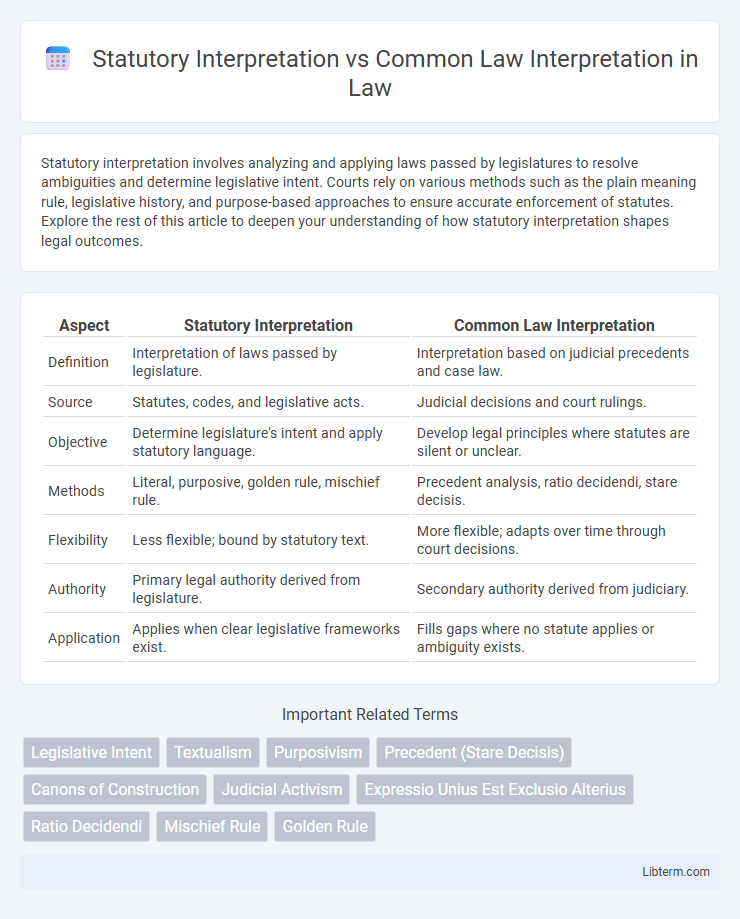Statutory interpretation involves analyzing and applying laws passed by legislatures to resolve ambiguities and determine legislative intent. Courts rely on various methods such as the plain meaning rule, legislative history, and purpose-based approaches to ensure accurate enforcement of statutes. Explore the rest of this article to deepen your understanding of how statutory interpretation shapes legal outcomes.
Table of Comparison
| Aspect | Statutory Interpretation | Common Law Interpretation |
|---|---|---|
| Definition | Interpretation of laws passed by legislature. | Interpretation based on judicial precedents and case law. |
| Source | Statutes, codes, and legislative acts. | Judicial decisions and court rulings. |
| Objective | Determine legislature's intent and apply statutory language. | Develop legal principles where statutes are silent or unclear. |
| Methods | Literal, purposive, golden rule, mischief rule. | Precedent analysis, ratio decidendi, stare decisis. |
| Flexibility | Less flexible; bound by statutory text. | More flexible; adapts over time through court decisions. |
| Authority | Primary legal authority derived from legislature. | Secondary authority derived from judiciary. |
| Application | Applies when clear legislative frameworks exist. | Fills gaps where no statute applies or ambiguity exists. |
Introduction to Statutory and Common Law Interpretation
Statutory interpretation involves analyzing and applying the precise language of legislation enacted by the government, focusing on the literal meaning, purpose, and legislative intent within legal provisions. Common law interpretation relies on judicial precedents and principles developed over time through court decisions, emphasizing consistency and adaptability in applying legal rules. Understanding the distinction between statutory and common law interpretation is crucial for accurate legal analysis and effective application of the law.
Defining Statutory Interpretation
Statutory interpretation involves the process courts use to construe and apply legislation, focusing on the intent of the legislature and the precise meaning of statutory language. It requires analyzing the text, context, purpose, and legislative history to resolve ambiguities and implement the law as intended by lawmakers. Unlike common law interpretation, which relies on judicial precedents and principles developed through courts, statutory interpretation centers on deciphering written statutes enacted by legislative bodies.
Understanding Common Law Interpretation
Common law interpretation relies on judicial decisions and precedents to determine the meaning of legal texts when statutes are ambiguous or silent. This method prioritizes the principles of stare decisis, ensuring consistency and predictability in legal rulings by referencing previous court judgments. Judges analyze prior cases, contextual facts, and evolving societal norms to interpret laws flexibly within the framework of established legal doctrines.
Key Principles of Statutory Interpretation
Key principles of statutory interpretation include the literal rule, where courts apply the plain and ordinary meaning of the text, and the golden rule, which permits modification of the literal meaning to avoid absurd results. The purposive approach seeks to ascertain the legislature's intention and gives effect to the statute's purpose beyond just the text. These principles contrast with common law interpretation, which relies on judicial precedents and evolving case law to interpret legal rules.
Core Principles of Common Law Interpretation
Common law interpretation relies heavily on the principle of judicial precedent, ensuring consistency and predictability by following past decisions. It emphasizes the literal meaning of the text while considering the context and purpose to avoid unjust or absurd outcomes. Courts also apply the ejusdem generis and noscitur a sociis canons to interpret ambiguous terms based on their surrounding language and legal usage.
Tools and Methods Used in Statutory Interpretation
Statutory interpretation employs tools such as the literal rule, purposive approach, and golden rule to ascertain legislative intent and clarify ambiguous language. Methods include examining the statute's text, context, preamble, and legislative history to resolve ambiguities and apply the law accurately. Judges may also use intrinsic aids like definitions and schedules, as well as extrinsic aids such as parliamentary debates and legal dictionaries.
Tools and Methods Used in Common Law Interpretation
Common law interpretation relies heavily on judicial precedents, applying the principle of stare decisis to ensure consistency and predictability in legal rulings. Judges utilize intrinsic tools like the literal rule, golden rule, and purposive approach to discern legislative intent from the language of statutes and prior case law. Extrinsic materials such as historical context, prior judgments, and authoritative commentaries also support the common law interpretive process, enhancing the nuanced application of legal principles.
Differences Between Statutory and Common Law Interpretation
Statutory interpretation involves deciphering the meaning and application of written laws enacted by legislatures, relying heavily on the text, context, and legislative intent. Common law interpretation, in contrast, is based on judicial decisions and precedents that evolve through court rulings, emphasizing past case outcomes and principles of equity. The key difference lies in statutory interpretation being anchored to codified statutes, while common law interpretation derives meaning from judicially created rules and legal traditions.
Practical Examples Illustrating Each Approach
Statutory interpretation involves analyzing legislative texts such as the Clean Air Act to determine regulatory limits on emissions, while common law interpretation relies on judicial precedents like the case of Donoghue v Stevenson to define principles such as duty of care. Courts use statutory interpretation to resolve ambiguities in statutes by applying methods like the literal rule, as seen in the Supreme Court's reading of the Affordable Care Act provisions. In contrast, common law interpretation evolves through decisions like Brown v Board of Education, where judges reinterpret existing legal doctrines to address societal changes.
Implications for Legal Practice and Judicial Decision-Making
Statutory interpretation requires judges to apply legislative intent and textual analysis, ensuring laws are consistently enforced according to codified statutes, whereas common law interpretation relies on precedents and judicial reasoning to adapt legal principles to evolving societal contexts. This distinction impacts legal practice by shaping advocacy strategies: statutory cases demand precise statutory analysis, while common law cases require thorough precedent research. Judicial decision-making is influenced by the interpretative approach, as statutory methods promote legal certainty, while common law allows flexibility and incremental legal development.
Statutory Interpretation Infographic

 libterm.com
libterm.com